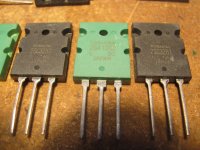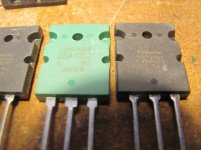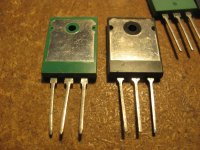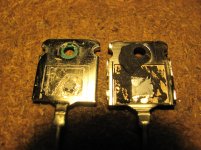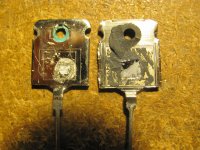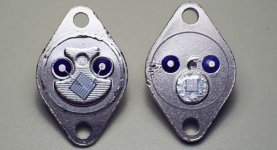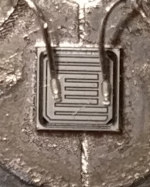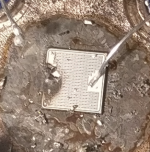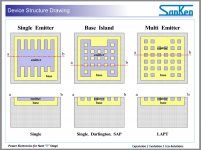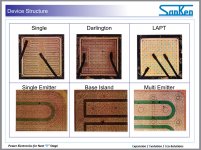Yes it does, if you were interested in understanding why some transistors are better than others. End user might pick the one with the better ballasting scheme, data sheet parameters aside.
If that die orignally came out in a TO-3, it would have been assigned a different type number. Now that opens another can of worms - determining what that type number WAS. (Not IS, because it will have been discontinued long before the A1302 was).
If that die orignally came out in a TO-3, it would have been assigned a different type number. Now that opens another can of worms - determining what that type number WAS. (Not IS, because it will have been discontinued long before the A1302 was).
Can you explain how you can tell with a regular microscope how many emitters a die has ?
I can understand it for a ring-emitter transistor, as those are clearly visible. But ime the dies of e.g. Toshiba A1094/A1095/C2564/C2565 do not look all that different to regular finger-emitter bipolar dies seen from the top.
Add to that, that A1301/A1302/C3280/C3281 are a totally different breed.
(Fujitsu has a patent for a power device with a multi-parallel transistor die, btw)
I can understand it for a ring-emitter transistor, as those are clearly visible. But ime the dies of e.g. Toshiba A1094/A1095/C2564/C2565 do not look all that different to regular finger-emitter bipolar dies seen from the top.
Add to that, that A1301/A1302/C3280/C3281 are a totally different breed.
(Fujitsu has a patent for a power device with a multi-parallel transistor die, btw)
Yes it does, if you were interested in understanding why some transistors are better than others. End user might pick the one with the better ballasting scheme, data sheet parameters aside.
If that die orignally came out in a TO-3, it would have been assigned a different type number. Now that opens another can of worms - determining what that type number WAS. (Not IS, because it will have been discontinued long before the A1302 was).
If your project is influenced by so minor and insignificant details of the construction of transistors, then is not a project well done.
We are talking about high end audio amplifier and not about building a broadcasting AM station.
It's not minor and insignificant when a transistor has 3X margin to data sheet SOA vs. 20% - both of which may cross to the same ECG number. The construction of the transistor has everything to do with this.
If your project is influenced by so minor and insignificant details of the construction of transistors, then is not a project well done.
We are talking about high end audio amplifier and not about building a broadcasting AM station.[/QUOTET
The small details sometimes make a big diference in the final quality of a project,like for example using the fastest transistors available for Audio use of a reputable manufacturer instead of chineese crap or using cheap electrolytic capacitors instead of panasonic or elna special for audio.
Best regards
The small details sometimes make a big diference in the final quality of a project,like for example using the fastest transistors available for Audio use of a reputable manufacturer instead of chineese crap or using cheap electrolytic capacitors instead of panasonic or elna special for audio.
Best regards
Exactly like oxygen free cooper cable, 100's of $ hand wound capacitors, gilded cooper foil wound coils and other audiophile snake oil.
I suggest to read and to understood these pages:
Myths in Audio
Cables, Interconnects and Other Stuff - The Truth
and maybe many others....
Exactly like oxygen free cooper cable, 100's of $ hand wound capacitors, gilded cooper foil wound coils and other audiophile snake oil.
I suggest to read and to understood these pages:
Myths in Audio
Cables, Interconnects and Other Stuff - The Truth
and maybe many others....
Ok, i agree that are lots of audiophile snake oil in many things in audio electronics, but i also know that we can achieve much better results in a audio amplifier if we select some key components like transistors and capacitors, but we dont need a 300 Euro capacitor to achieve good results in a circuit. A 2SC3281 is much better for audio than a 2N3055. As we say in my country " THE GOOD GRAPES MAKE THE GOOD WINE"
Best regards
"If that die orignally came out in a TO-3, "
Motorola made some in TO-3 (discontinued).
http://doc.chipfind.ru/pdf/motorola/mj3281a.pdf
Motorola made some in TO-3 (discontinued).
http://doc.chipfind.ru/pdf/motorola/mj3281a.pdf
Last edited:
Today i went to visit an old friend who has a small repair shop in a city nearby, and speaking to him i asked if he knows this transistors (2SA1302 and 2SC3281) then he said he used some and still have some left in stock, and bought them many years ago, so i bought 4 pairs, and post here the photos for you, maybe can tell me if they are fakes or the real ones. Personaly i think are real ones, because he told me that bought them more than 10 years ago...so what is your opinion ? Maybe later i will try to "open" one to check,but if they are real,i will miss one pair. He bought them, he said for about 5 Euros each at that time.
Attachments
Last edited:
They look really fake to me. Toshiba had veeeery high quality standards, and the printing on those is all off (never seen that on an original part). Also, the legs aren't the same on the green and the black parts you have there.
These are real:

These are real:

They look really fake to me. Toshiba had veeeery high quality standards, and the printing on those is all off (never seen that on an original part). Also, the legs aren't the same on the green and the black parts you have there.
These are real:
An externally hosted image should be here but it was not working when we last tested it.
Yes, maybe you are right, do you know a good way that i can use to "open" one of them to check the die to see if they are fake or not without destroy everything ? maybe a hammer works ?
There are some solvents that can dissolve the case but I do not remember what type.....
Sorry, maybe you can find on internet....
Sorry, maybe you can find on internet....
There are some solvents that can dissolve the case but I do not remember what type.....
Sorry, maybe you can find on internet....
OK ! i just used the hammer and it worked ! The picture in the left is the 2SA1302 wich is clearly a fake with only 2mm die, but the 2SC3281 has a die of 5 mm, so i assume it is a genuine one.
Attachments
EL's green ones are fake, the black ones are probably real. The black ones use modern laser marking - and the green ones are supposed to "look" like they do. But back when they did make the green PNPs, they were screen printed like Welcome's -which are real. (How can you *really* tell? They came out of working equipment...) EL's green ones have the wrong leads - Toshiba never used ones that were squared off by the pacakge. And the mounting hole size is inconsistent.
The genuine one also has a laser-etched heat spreader. Which is needed to prevent "tin whiskers" on soldered die attach, and certain epoxies. The fake didn't go to that much trouble.
different dies
Oics attached show a(blown) die from a 2sa1065, clearly visible the many emitters
a philips high Ft bdy90 with only a third of the power of the toschiba and a picture of a real and fake mj15003.
2sa1065 e.g. , and the fujitsu 2sa1043 allso , there bwere moreIf you could get a microscope on the die, you could see for yourself. But these dies were never available in a TO-3 where you could get at it without killing it.
Oics attached show a(blown) die from a 2sa1065, clearly visible the many emitters
a philips high Ft bdy90 with only a third of the power of the toschiba and a picture of a real and fake mj15003.
Attachments
That looks like 80-some-odd emitters. And one of the highest fT Toshiba ever made in a die that large. I liked to use those for *drivers* for big banks of TO-3’s back in the day. Still have a couple of big EF3 amps with the C2565/A1095 in that position. It gave good composite fT and gain linearity using rugged outputs. The others are just a single 10 to 20 *finger* emitter structure which is typical.
What did you use to de-cap the package? Must have been some kind of nasty solvent….
What did you use to de-cap the package? Must have been some kind of nasty solvent….
- Home
- Amplifiers
- Solid State
- How many transistors inside 2SA1302/2SC3281 ?
